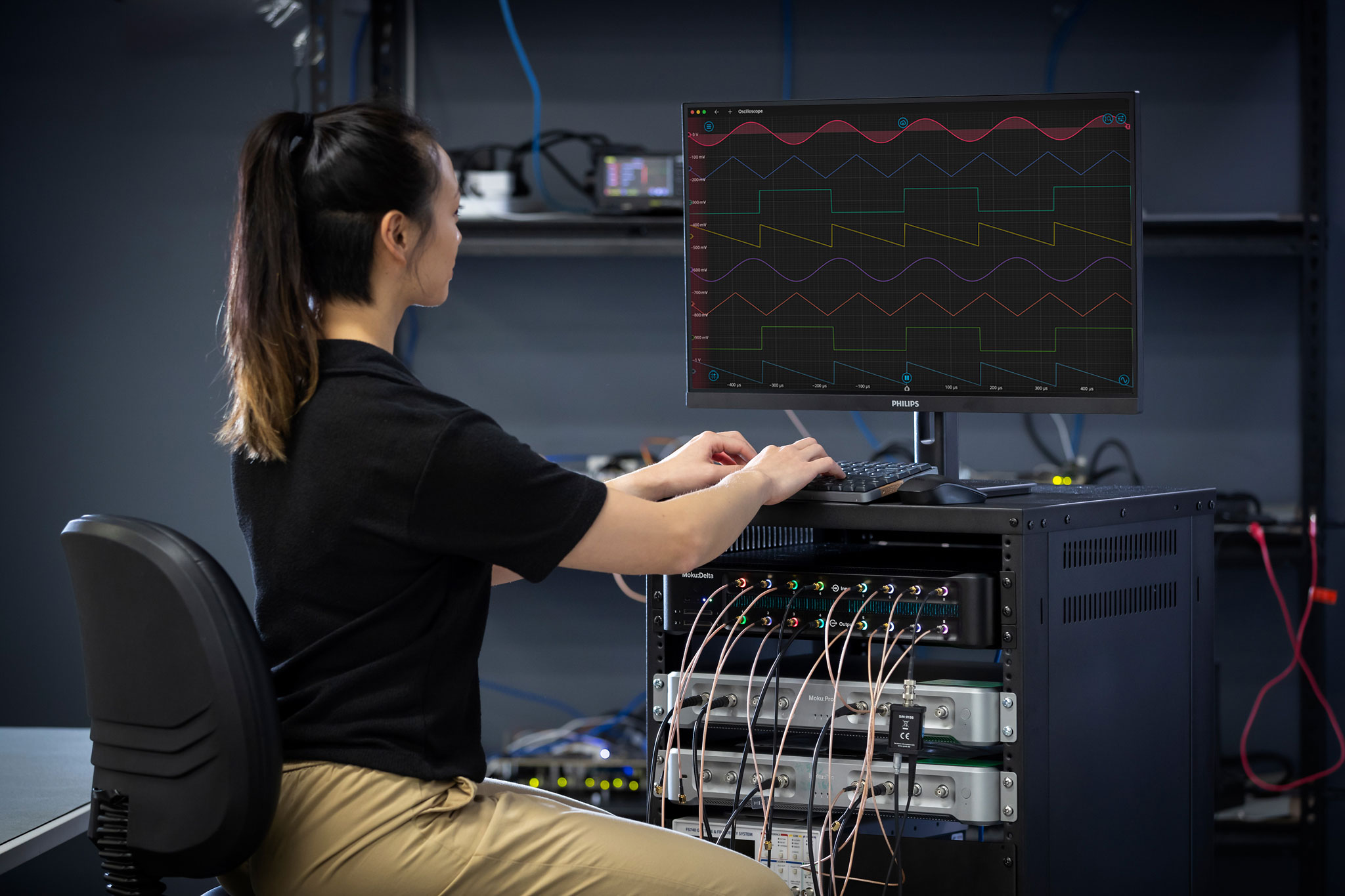New upgrades launched today for Moku:Lab, Moku:Pro, and Moku:Go to enable multi-instrument and customization capabilities across the entire Moku product line, strengthen API support, improve the capabilities of multiple software-defined instruments, and support a broader range of use cases for closed-loop control systems, precision spectroscopy, microscopy, and more.
Moku version 3.0 runs on all three devices, improving consistency in user experience and code portability, and ensuring greater development efficiency to speed up future feature enhancements. The latest release brings the Phasemeter to Moku:Go, rounds out desktop support for all Moku:Pro instruments, and adds many significant upgrades to Moku:Lab, our original product — underscoring our commitment to developing software-defined test and measurement solutions that get better over time.
Moku:Lab upgrades
Moku version 3.0 brings exciting new enhancements to Moku:Lab, including Multi-instrument Mode and Moku Cloud Compile for the first time. Moku:Lab now offers Windows, macOS, and iPadOS support for all instruments, as well as upgraded API support. Moku:Lab has also inherited many instrument features that until now were only available on Moku:Pro and Moku:Go. Check out the full list of updates below.
Multi-instrument Mode and Moku Cloud Compile
With Moku:Lab, you can now enable Multi-instrument Mode to use two instruments simultaneously, and leverage Moku Cloud Compile to quickly write and deploy VHDL code to enable custom features. These upgraded capabilities are available to all current Moku:Lab users at no additional charge, just a simple software download.
Frequency Response Analyzer
The Frequency Response Analyzer offers a range of new features that enhance its capabilities. The maximum frequency has been increased from 120 MHz to 200 MHz, and the sweep resolution has been increased from 512 points to up to 8192 points, with a new progress display on the graph. A new Dynamic Amplitude feature automatically optimizes output signals for the best measurement dynamic range. Finally, a new In/In1 measurement mode has been added, and the frequency axis can now be locked to prevent accidental changes during a long sweep. We’ve added input saturation warnings, and you can measure input signals in dBVpp and dBVrms in addition to dBm. The math channel now supports complex-valued equations, allowing for new types of transfer function measurements.
Laser Lock Box
The Laser Lock Box now offers a new block diagram that clearly illustrates the scan and modulation signal paths. Additionally, we’ve added a new locking stages feature that allows you to customize the lock procedure to your specific needs. The low-frequency phase-locked loop (PLL) locking performance has also been improved, and phase values are now measured with six-digit precision. The minimum PLL frequency has been reduced to 10 Hz, and the external PLL signal can now be frequency multiplied up to 250x or divided down to 0.125x for use in demodulation.
Lock-in Amplifier
The Lock-in Amplifier offers improved performance for low-frequency PLL locking, decreased minimum PLL frequency to 10 Hz, and the ability to frequency multiply the external PLL signal up to 250x or divide it down to 0.125x for use in demodulation. Additionally, phase values now have six-digit precision.
Oscilloscope
The Oscilloscope now offers a deep memory mode that allows you to save up to 4 MSa per channel at a full sample rate of 500 MSa/s.
Phasemeter
You can now output the frequency offset and amplitude of the Phasemeter as analog voltage signals, with the added ability to have a DC offset added to the output signals. The phase-locked sine wave output can now be frequency multiplied up to 250x or divided down to 0.125x, allowing for more flexibility in demodulation. We’ve also improved the bandwidth range, now from 1 Hz to 1 MHz. You can also take advantage of advanced phase wrapping and auto-reset functions to further enhance precision and accuracy.
Spectrum Analyzer
The Spectrum Analyzer now features an improved noise floor, providing better sensitivity for low-level signals. It also includes new scaling options with logarithmic Vrms and Vpp scales for more intuitive signal analysis. Additionally, five new window functions have been added (Bartlett, Hamming, Nuttall, Gaussian, Kaiser) to give you more flexibility when conducting signal processing and analysis.
Waveform Generator
The Waveform Generator now includes a noise output feature, which gives you the ability to add noise to your generated signals. We’ve also added a pulse-width modulation (PWM) feature and enabled six-digit precision for phase values, allowing for more precise waveform creation.
API support
Upgraded API support brings better support for all instruments and programming environments, as well as consistency with other Moku devices. Please note that Moku version 3.0 is not compatible with version 1.9 APIs. You must install new libraries, and update all of your code to use the new libraries. If required, you can downgrade to version 1.9 as needed (e.g., if you can’t port your API scripts to the new libraries). Migration guides are available here. If you need support or have questions about upgrading or downgrading software versions, contact us at support@liquidinstruments.com.
Additional updates
The equation editor, which can be used to generate custom waveforms in the Arbitrary Waveform Generator and custom filter kernels in the FIR Filter Builder, now supports sinc and square wave functions. Binary LI files created during data logging can now be converted automatically to CSV, MATLAB, or NumPy formats when downloading them from the device.
Moku:Pro upgrades
We’ve brought the Phasemeter to the Moku:Pro Windows and macOS desktop apps. With this update, all instruments are now supported on desktop for Moku:Pro. You can now add the PID Controller to an output channel for the Lock-in Amplifier in Multi-instrument Mode. We’ve also improved inter-instrument data resolution for the PID Controller and Frequency Response Analyzer in Multi-instrument Mode. Finally, we’ve increased the maximum frequency of the Frequency Response Analyzer from 300 MHz to 500 MHz for greater performance in higher-bandwidth applications.
Moku:Go upgrades
The Phasemeter is now available as an add-on, for-purchase option for Moku:Go. To get the Phasemeter, visit our webstore or contact us at info@liquidinstruments.com. As with Moku:Pro, we’ve also improved inter-instrument data resolution for the PID Controller and Frequency Response Analyzer in Multi-instrument Mode.
Upgrade your existing instruments at no cost
For the software-defined instruments that you already own, the new features are available for free through a simple software upgrade. To add new instruments, including the Phasemeter for Moku:Go, visit our webstore or contact us at info@liquidinstruments.com.
You can download the Windows and Mac app update here, or the iPad app update here. For step-by-step instructions on updating, check out this Knowledge Base article.
We look forward to increasing the capabilities of our software even more over time to give you new ways to optimize your workflow and accelerate research and discovery.
Have questions?
We’re here to help! Contact us at support@liquidinstruments.com.







